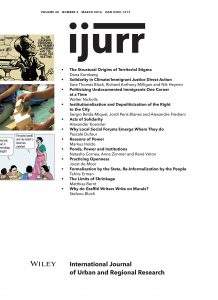SHI Special Issue: “Beyond behavior? Institutions, interactions and inequalities in the response to antimicrobial resistance”

A new free special issue of Sociology of Health & Illness on Institutions, interactions and inequalities in the response to antimicrobial resistance, edited by Catherine Will is available to read, here.
Antimicrobial resistance (AMR) has come to prominence as a priority for policy makers and a subject for media debate, following advocacy by the Chief Medical Officer (Davies 2015). The concept refers to the emergence and spread of strains of common infections that can no longer be treated by existing antibiotic classes, as bacteria change in response to exposure to antibiotics. The concept is known to many, not least due to the work of Dubos (1959) which informed early critical accounts of biomedicine and its claims. Resistance is becoming increasingly clinically important because of the lack of new classes of antibiotics and the spread of resistance to older drugs through transfers of genetic material as well as inheritance. Recent work in sociology and science and technology studies has examined different framings of this ‘social problem’ (Brown and Crawford 2008; Brown and Nettleton forthcoming; Morris, Helliwell and Raman 2016), however sociology has not often been seen as part of the solution. In this virtual special issue, Catherine Will draws attention to relevant work within the Sociology of Health and Illness and calls
for further research to inform policy and practical responses.
The full editorial is available here.
The issue includes the following free to read papers:
1. Allen, D., Braithwaite, J., Sandall, J. and Waring, J. (2016)
Towards a sociology of healthcare safety and quality.
Sociology of Health & Illness, 38, 2, 181–197.
2. Armstrong, D. and Ogden, J. (2006)
The role of etiquette and experimentation in explaining how doctors change behaviour: a qualitative study.
Sociology of Health & Illness, 28, 7, 951–968.
3. Aveling, E.-L., Parker, M. and Dixon-Woods, M. (2016)
What is the role of individual accountability in patient safety? A multi-site ethnographic study.
Sociology of Health & Illness, 38, 2, 216–232.
4. Barton, J., Dew, K., Dowell, A., Sheridan, N., Kenealy, T., Macdonald, L., Docherty, B., Tester, R., Raphael, D., Gray, L. and Stubbe, M. (2016)
Patient resistance as a resource: candidate obstacles in diabetes consultations.
Sociology of Health & Illness, 38, 7, 1151–1166.
5. Berg, M. (1992)
The construction of medical disposals Medical sociology and medical problem solving in clinical practice.
Sociology of Health & Illness, 14, 2, 151–180.
6. Brown B, Crawford P. (2008)
‘Post antibiotics apocalypse’: discourses of mutation in narratives of MRSA.
Sociology of Health & Illness 31, 4, 508-24.
7. Brown, B., Tanner, J. and Padley, W. (2014)
‘This wound has spoilt everything’: emotional capital and the experience of surgical site infections.
Sociology of Health & Illness, 36, 8, 1171–1187.
8. Calnan and Williams (1991)
Style of life and the salience of health: an exploratory study of health related practices in households from differing socio-economic circumstances.
Sociology of Health & Illness, 13, 4, 506-529.
9. Calnan, M. and Williams, S. (1992)
Images of scientific medicine.
Sociology of Health & Illness, 14, 2, 233–254.
10. Cohn, S. (2014)
From health behaviours to health practices: an introduction.
Sociology of Health & Illness, 36, 2, 157–162.
11. Crawford, P. and Brown, B. (2008)
Soft authority: ecologies of infection management in the working lives of modern matrons and infection control staff.
Sociology of Health & Illness, 30, 5, 756–771.
12. Dew, K., Chamberlain, K., Hodgetts, D., Norris, P., Radley, A. and Gabe, J. (2014)
Home as a hybrid centre of medication practice.
Sociology of Health & Illness, 36, 1, 28–43.
13. Gill, V. T., Pomerantz, A. and Denvir, P. (2010)
Pre-emptive resistance: patients’ participation in diagnostic sense-making activities.
Sociology of Health & Illness, 32, 1, 1–20.
14. Lauritzen, S. O. (1997)
Notions of child health: mothers’ accounts of health in their young babies.
Sociology of Health & Illness, 19, 4, 436–456.
15. Lehoux, P ;Saint-Arnaud, J ;Richard, L (2004)
The use of technology at home: what patient manuals say and sell vs. what patients face and fear.
Sociology of Health & Illness, 26, 5, 617-644.
16. Martin, G.P., Kocman, D., Stephens, T., Peden, C.J., Pearse, R.M. (forthcoming)
Pathways to professionalism? Quality improvement, care pathways, and the interplay of standardisation and clinical autonomy.
Sociology of Health & Illness.
17. McCoy , L (2009)
Time, self and the medication day: a closer look at the everyday work of ‘adherence’.
Sociology of Health & Illness, 31, 1, 128-146.
18. Murdoch, J., Salter, C., Cross, J., Smith, J. and Poland, F. (2013)
Resisting medications: moral discourses and performances in illness narratives.
Sociology of Health & Illness, 35, 3, 449–464.
19. Parry, R. (2009)
Practitioners’ accounts for treatment actions and recommendations in physiotherapy: when do they occur, how are they structured, what do they do?
Sociology of Health & Illness, 31, 6, 835–853.
20. Pill, R. (1987)
Models and management: the case of ‘cystitis’ in women.
Sociology of Health & Illness, 9, 3, 265–285.
21. Pilnick, A., Hindmarsh, J. and Gill, V. T. (2009)
Beyond ‘doctor and patient’: developments in the study of healthcare interactions.
Sociology of Health & Illness, 31, 6, 787–802.
22. Rasmussen, E.B. (forthcoming)
Balancing medical accuracy and diagnostic consequences: diagnosing medically unexplained symptoms in primary care.
Sociology of Health & Illness.
23. Reading, R. (1997)
Social disadvantage and infection in childhood.
Sociology of Health & Illness, 19, 4, 395–414.
24. Szymczak, J. E. (2016)
Infections and interaction rituals in the organisation: clinician accounts of speaking up or remaining silent in the face of threats to patient safety.
Sociology of Health & Illness, 38, 2, 325–339.
25. Toerien, M., Shaw, R. and Reuber, M. (2013)
Initiating decision-making in neurology consultations: ‘recommending’ versus ‘option-listing’ and the implications for medical authority.
Sociology of Health & Illness 35, 6, 873-890.
26. Waring, J., Allen, D., Braithwaite, J. and Sandall, J. (2016)
Healthcare quality and safety: a review of policy, practice and research.
Sociology of Health & Illness, 38, 2, 198–215.
27. Williams, P. and Gabe, J. (1987)
Research note: Urban-rural differences in tranquilliser prescribing: a critique of the ‘minimalist’ position.
Sociology of Health & Illness, 9, 3, 318–324.




